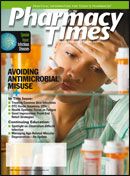Publication
Article
Pharmacy Times
Women's Health Watch
Breast Cancer Patients:Hot Flushes, Joint Problems a Positive Sign
Hot flushes, night sweats, and jointsymptoms may be good news for breastcancer patients getting endocrine treatment.These are signs of estrogen depletionor blockage and may indicate successfultreatment.
The study results indicated that 37.5%of women who reported hot flushes andnight sweats at the 3-month follow-upvisit had a lower rate of breast cancerrecurrence after 9 years (18%), comparedwith women who did not report vasomotorsymptoms (23%). Furthermore,the 31.4% of women who reported newjoint symptoms at the follow-up visithad a 14% rate of the cancer returning,compared with 23% who did not reportnew joint symptoms.
The researchers said that the differencesin cancer recurrence rateswere observed with both tamoxifenand anastrozole. The patients with andwithout these symptoms who receivedanastrozole had lower recurrence ratesthan those who received tamoxifen. Thestudy was published online October 30,2008, in The Lancet Oncology.
Migraines a Good Thing?
A new study indicates that women who experience migrainesmay have a 30% lower risk of developing breast cancer. Thestudy involved data on 3412 postmenopausal women. Of thesewomen, 1938 had been diagnosed with breast cancer and 1474had no history of the disease. The researchers explained thatestrogen levels may be the key to this correlation. High levelsof the hormone are linked with an increased risk of breast cancer.Women who experience migraines seem to have low levels of thehormone, which may account for the lower risk of breast cancer.
Ellen Drexler, MD, associate director of the Division ofNeurology at Maimonides Medical Center in Brooklyn, NewYork, questions the theory. She said that it is unclear that thelower incidence of breast cancer in women with migrainesproves the reason is lower hormone levels. The findings werepublished in Cancer Epidemiology, Biomarkers & Prevention(November 2008).
Women's Hands CarryMore Germs
Men and women have more bacteria on their hands than previouslythought. Women, however, win the contest for the numberof germs detected, according to a study recently reported inthe Proceedings of the National Academy of Sciences.
The skin on the palms of hands contains many bacterial communities.The researchers looked at the palms of 51 undergraduatestudents. A sampling of the entire DNA of microbes showedsome 322,000 gene sequences, or about 100 times more thanwas found in earlier studies of skin bacteria. On average, eachhand had about 150 different species of bacteria. Overall, >4700bacterial species were identified on all hands. As for women,the researchers detected more germ diversity, compared withmen. The investigators attributed it to different acidities on thehands, different production of sweat, variable hormones, andhow many times moisturizers or cosmetics are applied.
PID Ups Girls' Risk forRepeat STIs
A new study found that teenage girls treated for pelvic inflammatorydisease (PID) are more vulnerable to sexually transmittedinfections (STIs) not long after treatment. Although the studyfocused on inner-city girls in Baltimore, Maryland, teenage girlsacross the United States probably face similar problems associatedwith inner-city life and have behaviors that put them athigh risk for repeat STIs, said the researchers. The 4-year studyfollowed 80 girls who were diagnosed with PID and returnedfor a follow-up. Of those girls, 27 (34%) were diagnosed with atleast 1 STI over a 6-month period. Of the 27, 8 (30%) had at least2 STIs in the follow-up period. The researchers suggested thattreating PID "with a prescription and a brochure" is not enoughto change behavior and prevent future repeat infections.
"What we think we need is individually tailored counseling bya clinical provider...with each patient to determine what aspectsof her behavior put her at risk and must change," said leadinvestigator Maria Trent, MD.
Young Women NeedCalcium, Vitamin D, Too
Older women are not the only ones to benefit from calcium andvitamin D supplements. A new study of US female Navy recruitsfound that these nutrients also help younger, active womenlower their odds of stress fractures.
In the study, the women were undergoing 8 weeks of basictraining. The women were randomly divided into 2 groups. Onegroup was given daily supplements containing 2000 mg of calciumand 800 international units of vitamin D. The second grouptook a placebo. Reporting the findings at the recent OrthopaedicResearch Society, the researchers said that women who did nottake additional calcium and vitamin D were almost 25% moreprone to experience a stress fracture, compared with womenwho took the supplements.
F A S T F A C T: Approximately 75% of autoimmune diseases occur in women, most frequently in women of childbearing age.







